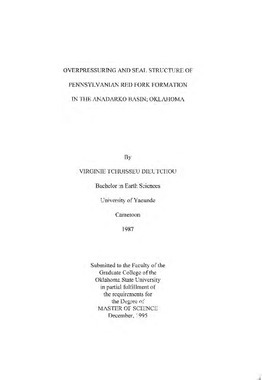| dc.description.abstract | Overpressuring, which is a phenomenon common to deep basins, had been detected in the Anadarko basin located in the western Oklahoma and the northern Texas Panhandle for more than a decade. Indeed, the Anadarko basin is the deepest basin in the North American craton. Overpressuring is maintained in deep basins over long geological periods by pressure seals. A pressure seal is a shell-like domain of low permeability sufficient to prevent fluids from escaping from a domain of rocks of relatively good hydraulic conductivity and porosity, called a "compartment". The presence of a Megacompartment Complex (MCC) in the Anadarko was first demonstrated by AI-Shaieb et aI., 1994. The Megacompartment Complex comprises mainly Pennsylvanian formations from the Morrow through Oswego formation and is enclosed by three types ofpressure seals: a basal seal, the Woodford shale, a top seal which cuts across stratigraphy. The lateral seal coincides to the South with the frontal zone of the Wichita Mountain uplift and to the eastern, western and northern boundaries with the convergence of the basal and top seals. The Red Fork Sandstone is one of the formations cut across by the top planar seal which dips gently southwest. The Red Fork Sandstone is an important producing reveals that the Red Fork Sandstone is overpressured inside the Megacompartment Complex and normally pressured on the northern shelf. The change of pressure gradients with tectonic setting suggests two distinctive pressure domains: a deep overpressured domain inside the MCC, located in the deep basinal setting, and a near-to-normally pressured domain located on the northern shelf. Moreover, the Red Fork sandstones of the MCC and ofthe northern shelf present evidence of distinctive and separate, characteristic morphological, textural, mineralogical and diagenetic overprints. The most obvious criterion distinguishing the two is the presence of repetitive small- to mediumscale diagenetic banding patterns that are in the deep overpressured Red Fork Sandstones. These patterns are noticeably absent in sandstones of the near-to-normally pressured Red Fork of the northern shelf. The origin ofthese bands is attributed to diagenetic alteration of shale host rock, due to deep burial diagenesis (AI-Shaieb et aI., 1994). Petrographic examination and x-ray diffraction of these bands reveals that the bands are essentially chloritic in nature (Power, R., 1991; AI-Shaieb et aI., 1994). | |
